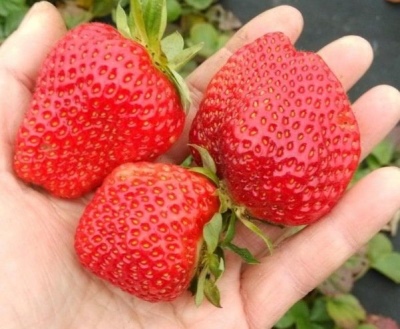
- Authors: American selection
- Name synonyms: Sweet Anna
- Taste: sweet
- The size: large
- Size, cm: 10-15 cm
- Weight: up to 50 g
- Yield rate: very high
- Yield: up to 2.6 kg per bush
- Repairability: Yes
- Advantages: easily adapts to different climatic and soil conditions
The Sweet Ann strawberry variety is a very recent development. It was first bred in California. This species belongs to the remontant group. It is characterized by increased resistance to various diseases. Sweet Ann strawberries are also called Sweet Annas.
Description of the variety
Sweet Ann has a high yield. In addition, ripe fruits of this species have a good balance of acid and sugar content. They boast excellent taste.
Ripening terms
This strawberry belongs to the remontant variety. This means the ability of the plant to bear fruit or bloom for a very long time. If such varieties are provided with the most favorable conditions for growth and development, then it will be possible to harvest the crop throughout the year.
Also, remontant varieties of vegetation, as a rule, easily tolerate winter periods. The first berries appear at the beginning of the summer season. Harvesting ends only after the onset of frost. The most active period of fruiting occurs from June to September.
Yield
This strawberry variety boasts a high yield. On average, about 2-2.6 kg of berries are harvested from one bush.
Berries and their taste
Sweet Ann has large berries with a bright and intense red color. They have a conical shape. Ripe fruits are rather large (10-15 centimeters). The weight of one fruit can reach approximately 50 grams. In addition, ripe berries have a sweet and aromatic taste. Their flesh is quite dense and juicy.
Growing features
This strawberry variety has a high level of resistance to various diseases and pests. In addition, the variety very quickly and easily adapts to various climatic and soil conditions.




Site selection and soil preparation
If you bought seedlings of such strawberries for growing, you should choose a suitable place for them in advance. For planting Sweet Ann, the best option would be a flat area without hills and large depressions, it should be well lit by the sun. In addition, the site must be reliably protected from cold winds. An area located on the south side of a fence, building or any other structure would be ideal.
For this variety, it is better to use light fertile soil that has neutral acidity. If the soil is too acidic, it can be treated with dolomite flour and lime. The soil before planting young seedlings is also worth preparing. To do this, carry out the digging of the selected place. Humus, superphosphate and potassium sulfate are added there.
All strawberry bushes will need to be placed in rows, planting vegetation in a checkerboard pattern. In this case, the distance between plantings should be at least 25-30 centimeters. The distance between the rows must be at least 50 centimeters. Remember that carrots, beans, and dill are the best precursors for such strawberries. It is not recommended to plant this crop after nightshade and pumpkin plants.

Pollination
This strawberry variety is self-fertile, which means that the plants can be pollinated with their own pollen. Fertilization often occurs even before the flower bud opens on the vegetation.
Self-fertile species allow you to get a full harvest even under adverse conditions. By planting such pollinating varieties in the garden, you can significantly increase the level of yield.

One of the important techniques in strawberry care is feeding. Regular fertilization guarantees a rich harvest. There are several different ways to feed strawberries, and each of them is designed for a specific period of plant development. During flowering, fruiting and after it, feeding should be different.

Diseases and pests
Sweet Ann has good resistance to diseases and parasites. But at the same time, the variety can still be affected by gray rot. To avoid its appearance, you should promptly remove all weeds on strawberry rows, and also cover the beds with a dense film during periods of heavy rains.
Sometimes Sweet Ann also suffers from slugs, spider mites. In this case, timely processing with hydrated lime and tobacco dust can help. To protect plants from nematodes, it is better to immediately plant them in rows between marigolds, which are then recommended to be buried next to the strawberries.

Strawberries are often subject to many dangerous diseases that can seriously undermine their condition.Among the most common are powdery mildew, gray mold, brown spot, anthracnose, and verticillosis. Before buying a variety, you need to inquire about its disease resistance.
Reproduction
The Sweet Ann strawberry variety produces quite a few mustaches, but enough to breed a small number of new plants. In this case, it will be necessary to substitute small containers with soil, which consists of equal proportions of fertile soil and peat, under the sockets formed on the bushes.
The mustache will need to be moisturized quite often. When the roots begin to gradually bare, new soil must be poured onto them.



















































































